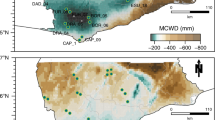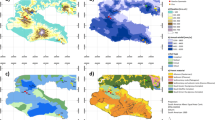Abstract
Although patterns of tree species distributions along environmental gradients have been amply documented in tropical forests1,2,3,4,5,6,7, mechanisms causing these patterns are seldom known. Efforts to evaluate proposed mechanisms have been hampered by a lack of comparative data on species’ reactions to relevant axes of environmental variation1. Here we show that differential drought sensitivity shapes plant distributions in tropical forests at both regional and local scales. Our analyses are based on experimental field assessments of drought sensitivity of 48 species of trees and shrubs, and on their local and regional distributions within a network of 122 inventory sites spanning a rainfall gradient across the Isthmus of Panama. Our results suggest that niche differentiation with respect to soil water availability is a direct determinant of both local- and regional-scale distributions of tropical trees. Changes in soil moisture availability caused by global climate change and forest fragmentation are therefore likely to alter tropical species distributions, community composition and diversity.
This is a preview of subscription content, access via your institution
Access options
Subscribe to this journal
Receive 51 print issues and online access
$199.00 per year
only $3.90 per issue
Buy this article
- Purchase on Springer Link
- Instant access to full article PDF
Prices may be subject to local taxes which are calculated during checkout


Similar content being viewed by others
References
Veenendaal, E. M. & Swaine, M. D. Limits to tree species distribution in lowland tropical rainforests. In Dynamics of Tropical Communities (eds Newbery, D. M., Prins, H. H. T. & Brown, N.) 163–191, 37th Symp. Brit. Ecol. Soc. (Blackwell, Oxford, 1998)
Webb, C. O. & Peart, D. R. Habitat associations of trees and seedlings in a Bornean rain forest. J. Ecol. 88, 464–478 (2000)
Harms, K. E., Condit, R., Hubbell, S. P. & Foster, R. B. Habitat associations of trees and shrubs in a 50-ha neotropical forest plot. J. Ecol. 89, 947–959 (2001)
Pyke, C. R., Condit, R., Aguilar, S. & Lao, S. Floristic composition across a climatic gradient in a neotropical lowland forest. J. Veg. Sci. 12, 553–566 (2001)
Condit, R. et al. Beta-diversity in tropical forest trees. Science 295, 666–669 (2002)
Bongers, F., Poorter, L., Van Rompaey, R. S. A. R. & Parren, M. P. E. Distribution of twelve moist forest canopy tree species in Liberia and Cote d’Ivoire: response curves to a climatic gradient. J. Veg. Sci. 10, 371–382 (1999)
ter Steege, H. et al. A spatial model of tree α-diversity and tree density for the Amazon. Biodiv. Conserv. 12, 2255–2277 (2003)
Schimper, A. F. W. Plant Geography upon a Physiological Basis (Clarendon, Oxford, 1903)
Gentry, A. H. Changes in plant community diversity and floristic composition on environmental and geographical gradients. Ann. Mo. Bot. Gard. 75, 1–34 (1988)
Daws, M. I., Mullins, C. E., Burslem, D. F. R. P., Paton, S. R. & Dalling, J. W. Topographic position affects the water regime in a semideciduous tropical forest in Panama. Plant Soil 238, 79–90 (2002)
Walsh, R. P. D. Climate. In The Tropical Rain Forest an Ecological Study 2nd edn (ed. Richards, P. W.) 159–202 (Cambridge Univ. Press, Cambridge, USA, 1996)
Givnish, T. J. On the causes of gradients in tropical tree diversity. J. Ecol. 87, 193–210 (1999)
Hubbell, S. P. The Unified Neutral Theory of Biodiversity and Biogeography (Princeton Univ. Press, Princeton, 2001)
Engelbrecht, B. M. J. & Kursar, T. A. Comparative drought-resistance of seedlings of 28 species of co-occurring tropical woody plants. Oecologia 136, 383–393 (2003)
Huston, M. A. Biological Diversity. The Coexistence of Species on Changing Landscapes (Cambridge Univ. Press, Cambridge, UK, 1994)
Tyree, M. T., Engelbrecht, B. M. J., Vargas, G. & Kursar, T. A. Desiccation tolerance of five tropical seedlings in Panama: Relationship to a field assessment of drought-performance. Plant Physiol. 132, 1439–1447 (2003)
Comita, L. S., Condit, R. & Hubbell, S. P. Developmental changes in habitat associations of tropical trees. J. Ecol. 95, 482–492 (2007)
Veenendaal, E. M. et al. Responses of West African forest tree seedlings to irradiance and soil fertility. Funct. Ecol. 10, 501–511 (1996)
Palmiotto, P. A. et al. Soil-related habitat specialization in Dipterocarp rain forest tree species in Borneo. J. Ecol. 92, 609–623 (2004)
Niinemets, Ü. & Valladares, F. Tolerance to shade, drought, and waterlogging of temperate northern hemisphere trees and shrubs. Ecol. Monogr. 76, 521–547 (2006)
John, R. et al. Soil nutrients influence spatial distributions of tropical tree species. Proc. Natl Acad. Sci. USA 104, 864–869 (2007)
Potts, M. D. Drought in a Bornean everwet rain forest. J. Ecol. 91, 467–474 (2003)
Malhi, Y. & Phillips, O. L. Tropical forests and global atmospheric change: a synthesis. Phil. Trans. R. Soc. Lond. B 359, 549–555 (2004)
Smithsonian Tropical Research Institute. ACP physical monitoring downloads. 〈http://striweb.si.edu/esp/physical_monitoring/download_acp.htm〉 (2006)
Condit, R. et al. Tropical forest dynamics across a rainfall gradient and the impact of an El Niño dry season. J. Trop. Ecol. 20, 51–72 (2004)
Pérez, R. et al. Tree species composition and diversity in the Upper Chagres River Basin, Panama. In The Rio Chagres, Panama: A Multidisciplinary Profile of a Tropical Watershed (ed. Harmon, R. S.) (Springer, Dordrecht, The Netherlands, 2005)
Condit, R., Hubbell, S. P. & Foster, R. B. Barro Colorado Forest census plot data. 〈http://ctfs.si.edu/datasets/bci〉 (2005)
Comita, L. S., Aguilar, S., Pérez, R., Lao, S. & Hubbell, S. P. Patterns of woody plant species abundance and diversity in the seedling layer of a tropical forest. J. Veg. Sci. 18, 163–174 (2007)
Engelbrecht, B. M. J., Kursar, T. A. & Tyree, M. T. Drought effects on seedling survival in a tropical moist forest. Trees (Berl.) 19, 312–321 (2005)
Welden, C. W., Hewett, S. W., Hubbell, S. P. & Foster, R. B. Sapling survival, growth, and recruitment: Relationship to canopy height in a neotropical forest. Ecology 72, 35–50 (1991)
McCune, B. Non-parametric habitat models with automatic interactions. J. Veg. Sci. 17, 819–830 (2006)
Becker, P., Rabenold, P. E., Idol, J. R. & Smith, A. P. Water potential gradients for gaps and slopes in a Panamanian tropical moist forest’s dry season. J. Trop. Ecol. 4, 173–184 (1988)
Acknowledgements
We thank the more than two dozen field assistants who conducted the extensive censuses and drought experiments. S. Aguilar and R. Perez were instrumental in species identifications, and S. Lao assisted with data management. The study was financially supported by the Andrew W. Mellon Foundation (T.A.K., B.M.J.E. and M.T.T.), the National Science Foundation (S.P.H. and L.S.C.), the University of Utah (T.A.K. and B.M.J.E.), the Center of Tropical Forest Science (B.M.J.E and L.S.C.) and the German Science Foundation (B.M.J.E.). We acknowledge logistical support provided by the Smithsonian Tropical Research Center and the opportunity to work in the area granted by the ‘Autoridad Nacional del Ambiente’ (ANAM) of Panama.
Author Contributions B.M.J.E. and L.S.C. analysed the compiled data sets and coordinated the writing. B.M.J.E., T.A.K. and M.T.T. conducted the drought sensitivity experiments. L.S.C. and S.P.H. managed the seedling census, and R.C. and S.P.H. the tree census, in the 50-ha forest dynamics plot. R.C. coordinated the establishment and census of the regional inventory network, and modelled species occurrence against dry season length. B.L.T. conducted soil nutrient analyses. All authors discussed the results and commented on the manuscript.
Author information
Authors and Affiliations
Corresponding author
Ethics declarations
Competing interests
Reprints and permissions information is available at www.nature.com/reprints. The authors declare no competing financial interests.
Supplementary information
Supplementary Information
This file contains Supplementary Information on the experimental drought sensitivity index, local species distributions, the relation of species light requirements to distributions, the relation of soil nutrient status to dry season length, on modelling dry season length, and on fitting species occurrence to dry season length. (PDF 184 kb)
Supplementary Notes
This file contains Supplementary Notes with details on the Supplementary Data 1, 3 and 4, Supplementary Figures and on the Supplementary Program. (PDF 32 kb)
Supplementary Data 1
This file contains Supplementary Data 1 which presents details for the 44 rainfall collection stations operated by the Panama Canal Authority. See Supplementary Notes for details. (PDF 30 kb)
Supplementary Data 2
This file contains Supplementary Data 2 which gives locations, elevations and predicted dry season length for the 122 tree inventory sites. (PDF 106 kb)
Supplementary Data 3
This file contains Supplementary Data 3 which gives information on the presence (1) or absence (0) of 44 species at 122 inventory sites in the Panama Canal area. See Supplementary Notes for details. (PDF 73 kb)
Supplementary Data 4
This file contains Supplementary Data 4 which gives the estimated habitat response for 44 species used in drought experiments. See Supplementary Notes for details. (PDF 48 kb)
Supplementary Figures
This file contains Supplementary Figures which show the fitted kernels for the 44 experimental species as a function of dry season duration. See Supplementary Notes for details. (PDF 6930 kb)
Supplementary Program
This file contains Supplementary Program. The file includes the R scripts for running the Gibbs sampler to fit an optimized Gaussian kernel to species occurrence as a function of dry season duration. See Supplementary Notes for details. (PDF 114 kb)
Rights and permissions
About this article
Cite this article
Engelbrecht, B., Comita, L., Condit, R. et al. Drought sensitivity shapes species distribution patterns in tropical forests. Nature 447, 80–82 (2007). https://doi.org/10.1038/nature05747
Received:
Accepted:
Issue Date:
DOI: https://doi.org/10.1038/nature05747
This article is cited by
-
The competitive relationship of scrub plants for water use in the subalpine zone of the Qilian Mountains in China
Environmental Science and Pollution Research (2024)
-
Drought-adapted leaves are produced even when more water is available in dry tropical forest
Journal of Plant Research (2024)
-
Intraspecific competition hinders drought recovery in a resident but not in its range-expanding congener plant independent of mycorrhizal symbiosis
Plant and Soil (2024)
-
Effects of moisture and density-dependent interactions on tropical tree diversity
Nature (2023)
-
Rainfall affects interactions between plant neighbours
Nature (2023)
Comments
By submitting a comment you agree to abide by our Terms and Community Guidelines. If you find something abusive or that does not comply with our terms or guidelines please flag it as inappropriate.



